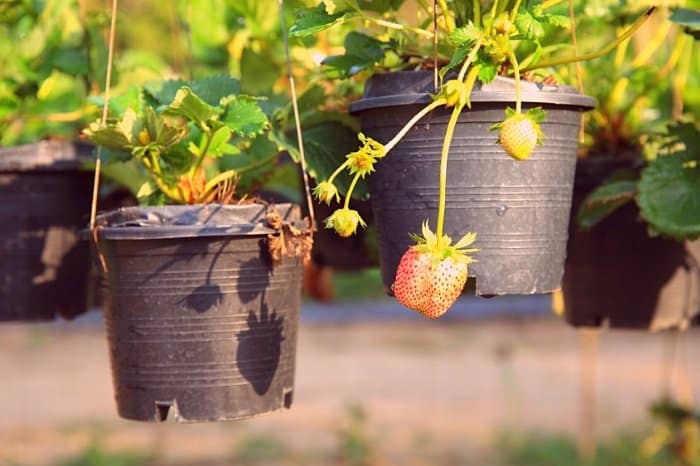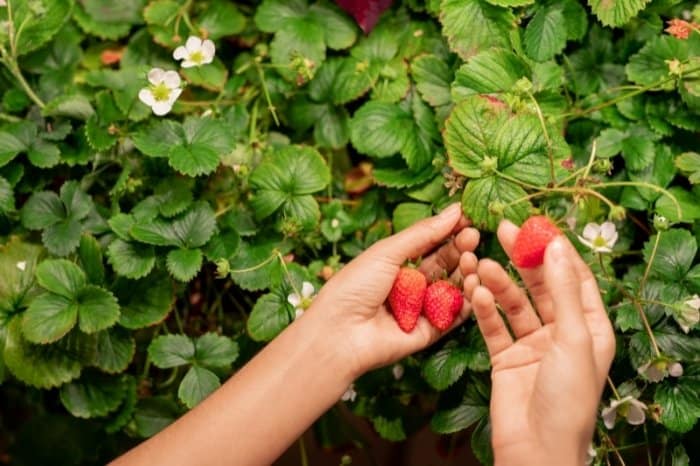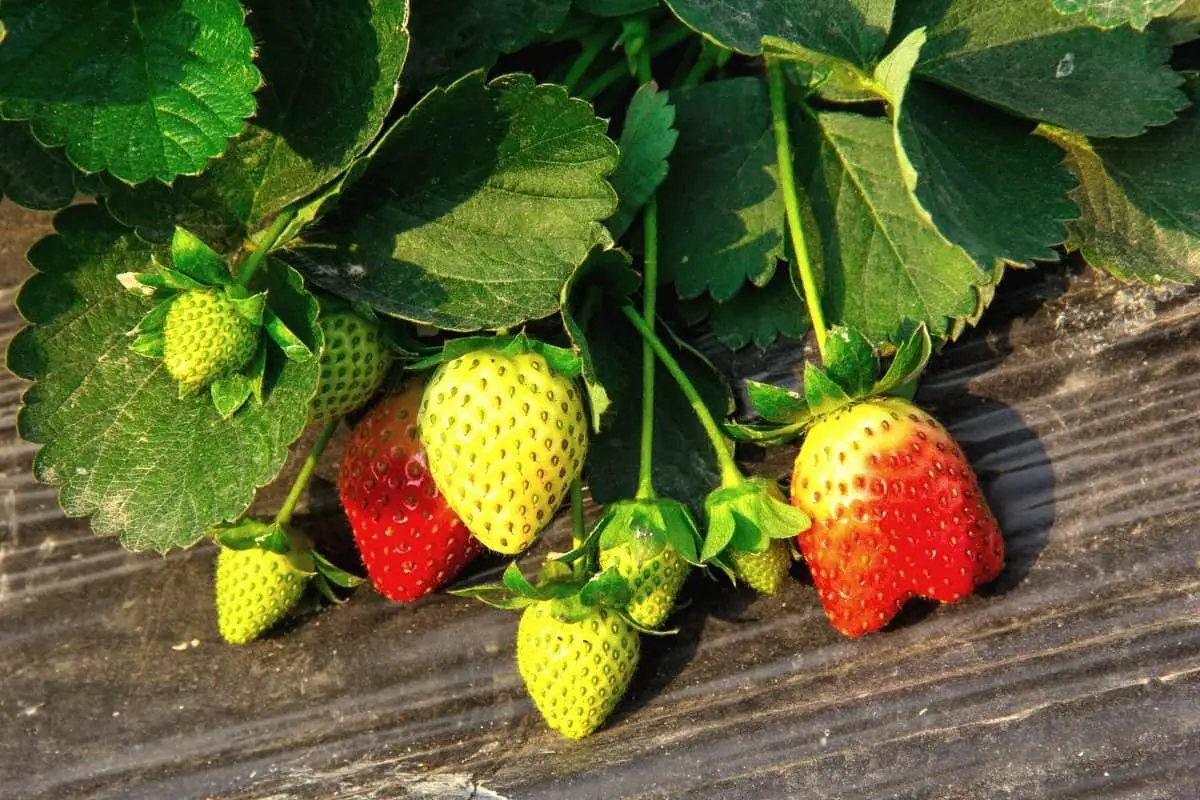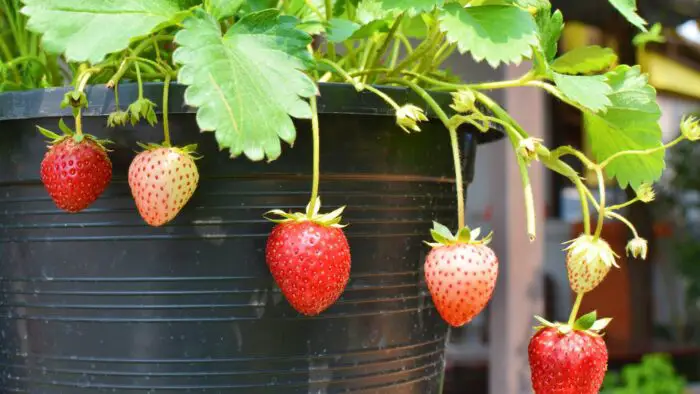Last Updated on March 22, 2023 by Griselda M.
If you’re wondering, can strawberries grow in shade, then we have the best fruit-growing tips for you. Are you ready to grow delicious strawberries in your home garden, and do you know if strawberries need sun or shade to thrive?
If you grow your own, you will notice a huge difference between homegrown strawberries and those sold at the grocery store. The flavor and texture are quite different, with the homegrown ones tasting better.
If you are ready to try growing your own, here are some tips to help you choose the best growing conditions, provide the best plant care and get a bountiful harvest.
Do Strawberries Plants Like Sun Or Shade?
Strawberry plants love the direct sun and do not thrive in full shade; they require at least 6 hours of direct sunlight each day.
During their growing season, these fruits need ample sun to attain healthy growth. However, for better fruit and stronger plants, 10 hours of sun daily is recommended.
The best way to grow strawberries is in good sunlight; they require full sun to produce the highest yields. It is, therefore, best to select a site that offers at least 6 hours of sun daily and is clear of tall or shadow-casting trees.

The strawberry flower prefers full sun to partial shade. It thrives in rich, moist soil. This plant is tolerant of slightly dry conditions. If your area has poor soil that has lots of clay or drains poorly, amend it with organic matter.
Strawberries are easy to grow! They thrive under slightly acidic soils and loamy soil. When planting them with companions, look for those that attract pollinators.
These fruits are permanent crops, so choose your placement wisely. It is easier to plant seedlings from a trusted nursery than plant seeds. If these fruits grow under less sun, the fruits will be small and not as sweet as those growing under full sunlight.
Avoid Doing These Things When Growing Strawberries
It is possible to meet farmers who have done everything to grow the perfect strawberries and still fail. You ought to know that sometimes it’s not what you do but what you don’t know that makes the difference.
Here are some important things you shouldn’t do when growing strawberry plants.
-
- Do not grow strawberries in the same soil you had grown tomatoes, potatoes, eggplants, and peppers. All these plants could be a host to the Verticillium dahlia fungi and Verticillium albo-atrium that cause the common Verticillium Rot in strawberry plants. The site you choose for planting your strawberries must not be home to any of these plants for the past 3 years.
-
-
Do not plant your strawberry in a spot that has too much sun, especially if you live in a region that experiences high daily temperatures. Even if this plant thrives in lots of sun, too much of it is disastrous to the fruit. It turns the fruits into soft and mushy pink strawberries, which is caused by sunburn. If you are receiving too much sun, cover your strawberries with canopies to protect them from the afternoon sun. Because gardeners have noticed the detriments of extended sun exposure, we are often faced with the question, can strawberries grow in shade?
-
Do not over-fertilize. One of the most common mistakes gardeners make is to over-fertilize their strawberry plants. The best way to grow your strawberries is by using organic manure to enrich the soil rather than using fertilizers. If you add too much fertilizer, you will end up with lots of healthy foliage and flowers but no fruits. If you want to use fertilizer, add it only twice – once when planting and once after harvesting the fruits.
-
Do not neglect your strawberry plants; rather, give them regular care. Show these plants some affection, and they will reward you handsomely.
-
Do not give your plant too much water. Strawberries require about 1 inch of water per week during their entire growing season. This ensures your soil is moist but not too wet. Overwatering kills your plant’s roots which later completely deteriorates the entire plant.
-
The Best Strawberries Types to Grow in Full Sun and Partial Shade
3 main types of strawberries include:
- Everbearing – Everbearing types like the Quinault produces two crops – one in June and another in September. It does well in USDA zones 6-8 – except for hot, humid areas – and may be your best bet to try. Can strawberries grow in the shade? This variety definitely can with the correct care and maintenance.
Miracle-Gro Performance Organics Edibles Plant Nutrition Granules
-
Day-neutral – Day-neutral types like Tristar will produce a continual but smaller crop starting from June to September. June-bearing varieties are best for short-season northern gardens as they offer a bigger summer harvest than ever bearers. However, these plants stop fruiting after the initial harvest.
-
June-bearing – June-bearing strawberries, like Shuksan, do well in zones 6 to 10, although some varieties are better for the local conditions than others. This type produces fruits earlier in warm climates. This means you can start enjoying your fruits in April.
Harvesting and Enjoying Your Strawberries
Harvest your ready fruits early in the morning when they are cool to reduce bruising. When your berries begin to ripen, watch them to see them turn their color until they are fully ripe for picking. Please leave a short stem attached to the green cap to extend their freshness as you pick them.
Strawberries are highly perishable. They do not last long once picked, so eat or refrigerate them right away. To help your strawberry fruit last a little longer, don’t wash them until you are ready to use them. Generally, a strawberry plant produces about 1 to 2 pounds of berries per season; you can plan your menus accordingly.
Enjoy your homegrown strawberries anytime and as much as you want. You will also enjoy the smiles of your loved ones as they bite into these sumptuous garden-fresh berries grown with your hands.

How Long Do Strawberries Take to Grow?
If you are curious about how long do strawberries take to grow, the following information is for you. Well, these delicious fruit plants take about 60 to 90 days to grow, depending on their environment and other essential aspects. This time involves the plant’s maturity from the get-go until they produce berries. Therefore, it is essential to provide your strawberry plants with the best growing conditions if you want to enhance their development during this time.
For this reason, it is vital to meet their demands when it comes to light recommendations, temperature, fertilization, and watering. Seeing that there are several varieties of strawberries that you can grow in your garden, you should also ensure that you know what kind you are growing and what needs that specific species requires to thrive. Keep in mind that there are more than 600 strawberry varieties that are grown throughout the world.
If you live in an area that does not receive enough sunlight, then you need to know the answer to the question, can strawberries grow in shade? This small piece of information will shorten the list and make choosing the right berry plant much easier.
Here are a few June-bearing berries to consider:
- Allstar berries
- Honeoye berries
- Kent berries
- Jewel berries
- Delmarvel berries
- Seneca berries
When Do Strawberries Bloom?
Ever wondered when strawberries bloom? Strawberry plants usually bloom in the early spring season. However, for the plants to bear fruit, they have to be pollinated by bees and other insects. Additionally, the type of berry plant you’re growing, the time that they were planted, and strawberry plant care and maintenance are important aspects that contribute to their flowering stage.
I mean, you cannot expect a plant that has been neglected or planted at the wrong time to thrive. For this reason, and depending on the region they’re planted in, it is essential to know, if can strawberries grow in shade. This is especially true if your area does not receive consistent sunlight. Domestic strawberries that are grown from runners do well in USDA zone 3 to 10, so you can expect flowers within the given time. You also need to remember that before strawberries produce an abundant fruit harvest, they need at least a year to become fully established.
How Long Do Strawberry Plants Last?
Whenever I am asked how long strawberry plants last or, do strawberries come back every year, I know that this is a gardener who has little to no experience growing these delicious berries. Firstly, you need to understand that strawberries are actually perennials, which means that they return every year. Also, strawberry plants have a lifespan of about six years on average.
However, you must note that these berries show a significant drop in fruit production after the second year. Although strawberries are perennials that renew and replicate themselves continuously, they are sometimes grown as annuals which are replanted yearly. Most plants produce a quart or so of strawberries each year, but overbearing varieties, like the Ozark, bear two main crops and additionally smaller amounts of fruit throughout the year.
Everbearing strawberries do well in USDA zones 4 to 8 with little maintenance. So, can strawberries grow in the shade? Yes, the overbearing varieties can grow and produce in shaded areas.
Do Strawberries Die in Winter?
Do strawberries die in winter? Well, if these berries are exposed to mildly freezing temperature conditions, then they are hardy enough to withstand it. In this case, the strawberry plant will not die in winter. Minimal care is required if you are growing your strawberries in a region that experiences mild winters. But, if you live in the Northern or Southern Hemisphere, you would need to give your strawberries extra care because of the harsher winter weather.
In this case, it is advisable to prune your plant after its fruits. Keep in mind that strawberry plants go into a dormant period where they rest, so they should be cut back to about three inches to encourage the development of new shoots before this happens. Remember to remove dead foliage, as these plants benefit from winterizing. You can expect a full spring crop if you take proper care of your strawberries in the cold season.
Conclusion
Biting into your own grown sun-ripened strawberries, still warm from the garden, is one of the greatest summer treats you will ever enjoy.
A few rows of plants will fill your biggest bowl with these juicy fruits. Even after subtracting the samples you chew on while picking, there is still a good amount left.
By growing different varieties in your garden or containers, you can enjoy these delicious fruits from spring until fall.
Now that we have answered the question, can strawberries grow in the shade, you can use the above tips to grow your strawberry fruits and enjoy all the recipes they come along with. You have enough to eat and try out new recipes—all the best in your strawberry gardening.
FAQs
Can strawberries grow in full shade?
Yes, they can. The plants will be smaller and bushier, but they will still produce delicious fruits. They will have to be planted deeper and mulched heavily, however. A lot of people plant strawberries in raised beds in their gardens, which allows the plants to receive more sun while still providing a nice amount of moisture.
Do strawberry plants need direct sunlight?
Strawberry plants require at least 6 hours of direct sunlight daily, preferably more. However, they can also be grown in a spot with some shade, but keep in mind that the plant will not grow as well under these conditions. How much sun you need is dependent on your region, the type of soil you have, and how large the pots are. The larger the pot, the less sun you need.
Where is the best place to plant strawberries?
The first thing you need to know before you begin planting is where you will be planting them. Strawberries are not like most other fruit trees or vegetables that can be grown in the ground. They need to be planted in raised beds or in a greenhouse.
Strawberries are very sensitive to cold weather, and will not produce well if they are planted in a frost-free area.
When should they be planted?
Strawberry plants should be planted in the fall, usually around November 1st or December 1st. You can plant them in your yard as long as it does not freeze and kill them.
Where do they grow?
Strawberries are grown in nearly every climate, and can be planted in almost any type of soil, including those that are too salty or wet for other crops. They grow well in areas with a long growing season, but also in those with short seasons.
Can strawberries grow indoors?
Yes. Strawberries can be grown indoors year-round and produce a bountiful harvest. The main things to remember when growing strawberries indoors are: 1. Strawberries need a lot of light. You’ll need a window that is at least 4 feet wide (the width of the strawberry container) and at least 8 feet high for optimal sunlight. If you have a sunny room, great!
Caroline is a gardener who loves to get down to the nitty–gritty of gardening. She proudly proclaims herself as a ‘dirt worshipper‘ and can often be found deep in the garden, covered in soil and singing to her plants. As a self–proclaimed ‘plant whisperer‘, Caroline believes that plants need love and attention just like any other living thing, and she loves to give them both. When she‘s not tending to her garden, you can often find her researching the latest gardening trends, or teaching others how to make their gardens thrive




